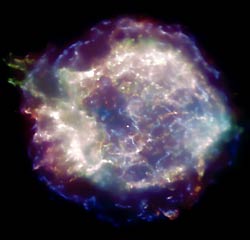
Cassiopeia A is the youngest known supernova remnant in the Milky Way. The X-ray image above, a 798-hour exposure by the orbiting Chandra X-ray Observatory, shows three X-ray energies (1, 2, and 5 kiloelectron volts) as red, green, and blue, respectively.
Where do cosmic rays come from? Although they were first identified on a balloon flight in 1912, their sources have been hard to find. Cosmic-ray particles are mostly protons, some helium nuclei, and a smattering of heavier nuclei. Their flight paths are twisted and tangled by interstellar magnetic fields, so the directions from which we see them arriving tell nothing about where they began. Only the very highest-energy cosmic-ray particles have enough momentum to fly across the galaxy in a nearly straight line, and these are extremely rare.
Recently a slight, unexplained excess of cosmic rays — only 0.1% above the sky average — was identified coming from the direction of Cygnus, according to a Japanese-Chinese team reporting last year Science. Cygnus is the direction forward along our local spiral arm of the Milky Way, suggesting that the arm has a magnetic field trapping cosmic rays within it to some slight degree. If the finding is confirmed (the Cygnus high-energy excess might consist of gamma-ray photons instead), it may help astronomers deduce a cosmic-ray origin.
The best bet for an origin is that particles get accelerated to their remarkably high energies by magnetic processes in the outer shells of supernova remnants. The newest evidence for this comes from a Chandra X-ray Observatory study of the expanding supernova remnant Cassiopeia A. Chandra scientists found that particles in the edge of Cas A are being accelerated about as efficiently as theoretically possible, all the way to cosmic-ray energies. In fact, in the remnant’s outer shock zone, the X-ray glow caused by local cosmic rays outshines the 10-million-degree gas of the remnant itself.
Scientists have known since the 1960s that a charged particle getting bounced around in a magnetic shock can be sped up to higher and higher energies almost indefinitely. Here, apparently, we see it happening.
 0
0
Comments
You must be logged in to post a comment.